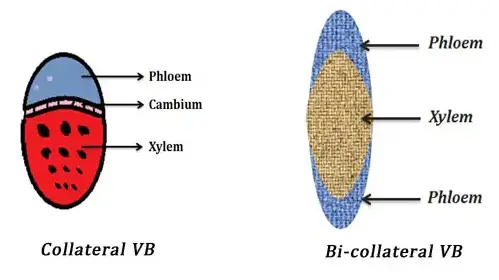Plants are complex organisms that rely on an intricate system of vascular bundles to transport nutrients, water, and sugars throughout their structures. These bundles are integral to plant health and development, serving as the lifeline between roots, leaves, and other organs. Among the various types of vascular bundles, collateral and bicollateral arrangements play crucial roles but differ significantly in structure and function.
Collateral vascular bundles consist of xylem on the inside and phloem on the outside, typically separated by a layer of cambium. In contrast, bicollateral bundles feature phloem both on the outer and inner sides of the xylem, with cambium layers separating each section. These structural differences are not just anatomical nuances; they reflect diverse functionalities and evolutionary adaptations specific to plant species.
The distinctions between these two types of vascular bundles are not merely academic but have practical implications for botany, agriculture, and environmental science. By examining the nuances of each, researchers can gain insights into plant resilience, efficiency in nutrient transport, and overall plant health, contributing to more effective agricultural practices and a deeper understanding of plant ecology.

Vascular Bundle Basics
What are Vascular Bundles?
Vascular bundles are key structural components in plants, functioning as the main conduits for transporting water, nutrients, and organic compounds. These bundles are analogous to the circulatory system in animals and are vital for maintaining the life processes of plants.
Role in Plant Physiology
Vascular bundles play a crucial role in plant physiology by:
- Transporting water and minerals from the roots to other parts of the plant via the xylem.
- Distributing sugars and organic nutrients produced during photosynthesis from the leaves to the rest of the plant through the phloem.
- Providing mechanical support and stability to the plant structure, helping it withstand various environmental stresses.
Components of Vascular Bundles
The primary components of vascular bundles include:
- Xylem: Tubes that transport water and dissolved minerals upwards from the roots.
- Phloem: Channels that convey sugars and other metabolic products downwards from the leaves.
- Cambium (in some plants): A layer of dividing cells that contributes to the growth in diameter of the stem and root.
Collateral Vascular Bundles
Definition and Structure
Collateral vascular bundles are arranged with the xylem on the inner side and the phloem on the outer side, typically separated by cambium in dicotyledons. This layout is pivotal for the efficient transport of fluids within the plant.
Types of Collateral Bundles
Collateral vascular bundles can be further categorized based on the presence or absence of cambium:
- Open Collateral: Contains cambium, allowing for continued growth and differentiation.
- Closed Collateral: Lacks cambium, found primarily in monocots and does not support secondary thickening.
Distribution in Plants
Collateral vascular bundles are widely distributed among various plant species, particularly dominant in dicots and some monocots. Their presence correlates with the plant’s developmental strategies and habitat adaptations.
Functional Significance
The functional importance of collateral vascular bundles lies in their ability to:
- Facilitate rapid and efficient transport of water and nutrients.
- Support plant growth and adaptation to terrestrial environments.
- Enable secondary growth in dicotyledons, crucial for trees and shrubs.
Bicollateral Vascular Bundles
Definition and Unique Features
Bicollateral vascular bundles are characterized by having phloem on both the inner and outer sides of the xylem. This unique arrangement allows for a more complex and versatile nutrient distribution system.
Structural Comparison with Collateral Bundles
Unlike the simpler structure of collateral bundles, bicollateral bundles feature an additional phloem layer that significantly enhances their functionality. This additional phloem can transport nutrients in two directions, which is especially beneficial for plants requiring more intensive nutrient distribution.
Occurrence in Plant Species
Bicollateral vascular bundles are less common and are predominantly found in specific families such as the Cucurbitaceae and Solanaceae. Their specialized structure is an adaptation to the specific needs of these plants, often related to their rapid growth rates and extensive branching.
Functional Roles
The roles of bicollateral vascular bundles extend beyond simple transport to include:
- Enhanced bidirectional nutrient transport, supporting more complex plant architectures.
- Improved adaptive capabilities in variable environmental conditions.
- Supporting the plant’s ability to manage growth and resource allocation effectively, which is vital for survival and reproduction.

Comparative Analysis
Structural Differences
The structural differences between collateral and bicollateral vascular bundles are significant and have profound implications for how plants transport nutrients and water. Collateral bundles, being simpler, feature xylem on the inside and phloem on the outside. In contrast, bicollateral bundles have a more complex arrangement with an additional phloem layer situated on the inner side of the xylem. This difference in structure allows bicollateral bundles to perform more sophisticated functions.
Differences in Function
Functionally, these structural differences translate into different capabilities:
- Collateral Vascular Bundles: Primarily support unidirectional nutrient and water transport, which is efficient for the plant’s upward growth and development.
- Bicollateral Vascular Bundles: Enable bidirectional transport, meaning they can move nutrients up and down more effectively. This is particularly advantageous for plants that need rapid delivery of nutrients to various growing regions, such as flowering parts or rapidly expanding leaves.
Ecological Implications
The ecological implications of these vascular bundle types are vast:
- Adaptation to Environments: Plants with bicollateral vascular bundles often thrive in environments where nutrient distribution needs to be highly efficient and adaptable, such as variable soil conditions.
- Resilience to Stress: The ability to transport nutrients in two directions can help plants better manage environmental stresses like drought or nutrient-poor soils.
Significance in Botany
Importance in Taxonomy
The type of vascular bundle is often a critical characteristic used in the taxonomy and classification of plant species. By examining the structure of these bundles, botanists can determine relationships between species and understand evolutionary adaptations:
- Identify Plant Families: Certain families, like Cucurbitaceae and Solanaceae, are known for their bicollateral bundles, which can be a defining feature.
- Evolutionary Insights: The development of different vascular bundle types offers clues about the evolutionary pressures that shaped a plant’s lineage and ecological niches.
Implications for Plant Breeding
Understanding vascular bundle structures is not only crucial for basic botanical science but also has practical implications in plant breeding:
- Enhanced Crop Performance: Breeders can select for traits associated with specific vascular bundle types to improve efficiency in water and nutrient transport, potentially leading to better drought resistance and nutrient use.
- Targeted Breeding Programs: Knowledge of vascular structures helps in designing breeding programs that target specific environmental adaptations, improving the resilience and yield of crops.
Research Applications
The study of vascular bundles extends into various research applications, influencing several fields within plant sciences:
- Agricultural Biotechnology: Genetic engineering can leverage insights from vascular bundle research to create plants that are more efficient in their physiological processes, improving agricultural sustainability.
- Ecological Conservation: Understanding how different plants adapt their vascular systems to their environments helps in the conservation of species and restoration of habitats.
- Pharmaceuticals: Research into how nutrients and chemicals are transported within plants can aid in the development of new pharmaceuticals derived from plants, as certain compounds might be concentrated or modified by the plant’s vascular system.
FAQs
What are vascular bundles?
Vascular bundles are groups of tube-like structures in plants that transport fluids, nutrients, and hormones throughout the organism. They are essential components of the plant’s vascular system, comprising xylem, phloem, and sometimes cambium, which facilitate the efficient movement of water, soluble organic compounds, and other substances.
How do collateral vascular bundles function?
Collateral vascular bundles are organized with xylem (responsible for water transport) on the inside and phloem (transports nutrients and sugars) on the outside. This arrangement allows for a balanced and effective distribution of resources from the roots to the leaves and other parts of the plant, vital for growth and development.
Where are bicollateral bundles typically found?
Bicollateral vascular bundles are less common than collateral ones and are typically found in certain dicots like Cucurbitaceae and Solanaceae families. Their unique structure, featuring phloem on both sides of the xylem, allows for more versatile nutrient distribution and adaptation to various environmental conditions.
What makes bicollateral vascular bundles unique?
Bicollateral vascular bundles are unique due to their arrangement of having two phloem sections, one on each side of the xylem, separated by cambium. This setup enhances the plant’s ability to distribute sugars and nutrients both upwards and downwards, which is particularly advantageous in rapidly growing and extensively branching plants.
Conclusion
The study of collateral and bicollateral vascular bundles offers valuable insights into the evolutionary adaptations and functional efficiencies of different plant species. By understanding these differences, scientists and agriculturists can better predict plant behavior in various environments, contributing to more sustainable agricultural practices and improved plant breeding techniques.
In summary, the distinction between collateral and bicollateral vascular bundles is more than a mere structural curiosity. It underscores the dynamic and adaptive nature of plant life, influencing everything from ecological balance to agricultural productivity and environmental management. Understanding these systems in depth allows us to harness their potential in new and innovative ways.

